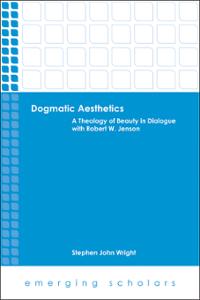 Dogmatic Aesthetics: A Theology of Beauty in Dialogue with Robert W. Jenson
Dogmatic Aesthetics: A Theology of Beauty in Dialogue with Robert W. Jenson
By Stephen John Wright
My rating: 4 of 5 stars
Goodness, truth, and beauty. This language of the “transcendentals” sounds inspiring and noble. But why do we believe in these things and what shapes our understanding of the good, the true, and the beautiful? Are there grounds for answers to these questions beyond our own experience and perception? Stephen John Wright, in this dialogue with his theological mentor Robert W. Jenson, and other theologians would answer in the affirmative, that is, in the Triune God.
But how might this God as the source of beauty be known? Wright would take issue with the analogia entis (analogy of being) approach of Erich Przywara and others and follow his mentor in proposing the centrality of Christology, our understanding of Christ, to our understanding of beauty. In other words, Wright would argue that we work not from our own experience up to an understanding of beauty in the being of God but rather that the being of God, as revealed in Christ, helps us understand beauty in our human context.
There are four foci to his argument and the organization of the book follows these. First there is beauty in relation to the Triune God. We understand there is a Trinity because of Christ’s incarnation but this then challenges us to understands the relations of the persons of the Trinity and the oneness of God and in so doing Jenson and Wright help us see the basis of harmony, proportion and simplicity in the Trinity.
Second, we understand beauty in the Incarnate Christ that reconciles on the cross suffering and ugliness in the creation with the grace revealed in our salvation and the restoration of all things through this act.
Third, in the creation of all things through Christ and the doctrine of creation ex nihilo we see that beauty and change and transience are not mutually exclusive and this distinguishes the beauty of the creation from the beauty of God. Wright does some interesting work here drawing upon Japanese aesthetics that are particularly attuned to the transitory beauty of creation.
Finally, and perhaps most interesting to me, was his treatment of beauty and the future or eschaton. As part of his discussion Wright notes a tension between language and music and that the poetic language often used to speak of the end points toward a reconciliation when we are caught up, to use Jenson’s metaphor, in the “great fugue” of God where our voices are joined to the harmony of the Trinity. (As a choral singer, I particularly loved that part!).
What struck me in reading Wright’s account is that this was a theology of beauty that was beautiful while never departing from scholarly engagement. Furthermore, and I guess this is because I would agree with his basic premise, I deeply appreciated the consistent recourse to the person and work of Christ as central to our understanding of beauty. This is truly a Christian and not simply a theist aesthetic. Finally, I found myself wanting both to read the work of Jenson, which I have not, and making a mental note to look for more from this young theologian.
Thank-you to Bob for sharing Dogmatic Aesthetics: A Theology of Beauty in Dialogue with Robert W. Jenson from his blog Bob on Books. An apt piece as one rejoices in Christ the King during a week of Thanksgiving in preparation for Advent. Note: I am very interested in reviews of other publications in Fortress Press’ new Emerging Scholars Series (July 2013- ): a curated, selective dissertation series dedicated to highlighting innovative and creative projects from new scholars in the fields of biblical studies, theology, and Christian history. To God be the glory! ~ Thomas B. Grosh IV, Associate Director, Emerging Scholars Network
Bob Trube is Associate Director of Faculty Ministry and Director of the Emerging Scholars Network. He blogs on books regularly at bobonbooks.com. He resides in Columbus, Ohio, with Marilyn and enjoys reading, gardening, choral singing, and plein air painting.

Leave a Reply